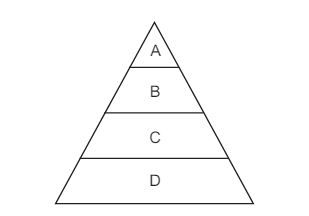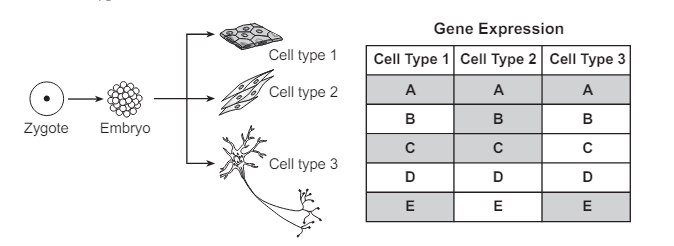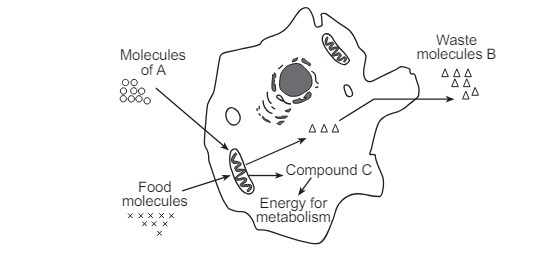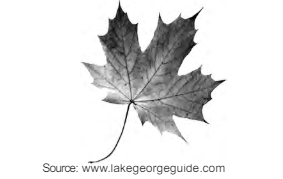As a population of organisms within a forest ecosystem increases, the size of the population is eventually limited by
(1) the overproduction of their food supply
(2) the size of similar populations in a nearby ecosystem
(3) a finite supply of water and nutrients
(4) a lack of competition
(3) a finite supply of water and nutrients
Below is a list of events that might occur in a cell.
A – synthesis of a new protein
B – a cell function changes
C – alteration of the base sequence on a strand of DNA
D – exposure to radiation
Which is the correct sequence in which these events could occur?
(1) D – B – A – C
(2) C – D – B – A
(3) B – A – C – D
(4) D – C – A – B
(4) D – C – A – B
Which two structures are directly involved in the normal development of a human fetus?
(1) uterus and placenta
(2) oviducts and ovaries
(3) testes and ovaries
(4) placenta and stomach
(1) uterus and placenta
Hydrangea, a commonly used landscaping flower, can have dramatically different colors, depending on the pH of the soil in which it is grown.

The differences in color demonstrate that
(1) traits can be expressed differently if the environment changes
(2) flower color is controlled only by genetic information
(3) abiotic factors do not have an effect on flower production
(4) pH is the only factor that affects flower growth
(1) traits can be expressed differently if the environment changes
Most scientists agree that a large asteroid struck Earth around 65 million years ago. The impact sent large amounts of fine dust particles into the atmosphere, which reduced the amount of sunlight reaching the planet. This event would have the most immediate effect on
(1) herbivores
(2) decomposers
(3) carnivores
(4) autotrophs
(4) autotrophs
Solar and wind power are options available to people interested in producing electricity while reducing their reliance on fossil fuels. A benefit of using these alternative energy sources is that they
(1) preserve natural resources for future generations
(2) increase the number of jobs required for mining coal
(3) ensure that supplies of fossil fuels will never decrease
(4) cost more to generate than all other sources of electricity
(1) preserve natural resources for future generations
Which statements correctly describes an organism’s genetic information?
(1) DNA molecules contain four subunits known as genes.
(2) Chromosomes are made entirely of protein.
(3) Genes are made of long sequences of chromosomes.
(4) DNA contains combinations of four base subunits.
(4) DNA contains combinations of four base subunits.
In humans, digestion depends on a variety of organs, such as the stomach, small intestine, and liver. The interactions of these organs provide evidence that
(1) each organ in the human body plays a role in only one life function
(2) organs in humans work together, resulting in the survival of the individual
(3) the most important life function in humans is the breaking down of food
(4) each life function is carried out by at least four different systems in humans
(2) organs in humans work together, resulting in the survival of the individual
Potato plants reproduce both sexually and asexually. Depending on the desired outcome, potato growers use both types of reproduction. A grower would most likely want the potato plants to reproduce asexually when
(1) selectively breeding new potato varieties
(2) there is a disease affecting similar potatoes growing in the area
(3) environmental conditions in the area are changing
(4) potatoes with the same traits are desired
(4) potatoes with the same traits are desired
The diagram below represents an energy pyramid.

At which level do the organisms all carry on both respiration and photosynthesis?
(1) A
(2) B
(3) C
(4) D
(4) D
Which statements most accurately describes the expected effect on the carrying capacity of a population if a change in a factor occurs?
(1) The number of snowshoe hares would increase if the population of Canadian lynx, a predator, also increased.
(2) The population of green algae would increase if chemical weed killers used on lawns entered the lake.
(3) The grass population would decrease if the foxes ate many rabbits.
(4) The population of Kaibab deer in Arizona would decrease if they overgrazed the plants
(4) The population of Kaibab deer in Arizona would decrease if they overgrazed the plants
The photic sneeze reflex, an inherited trait, causes some people to sneeze when they are exposed to bright sunlight. In the photic sneeze reflex, the sunlight acts as
(1) the effect of an environmental factor resulting in a genetic trait
(2) a biotic factor being passed from parent to offspring
(3) an environmental factor stimulating a response
(4) the recombination of genes resulting from sexual reproduction
(3) an environmental factor stimulating a response
The structures most directly involved in the synthesis of cellular proteins are the
(1) nucleus and ribosomes
(2) cell membrane and nucleus
(3) chloroplasts and cell membrane
(4) mitochondria and chloroplasts
(1) nucleus and ribosomes
An example of how a plant maintains homeostasis includes
(1) producing many seeds for reproduction
(2) controlling the amount of available solar energy
(3) recycling energy from the Sun
(4) regulating the action of guard cells
(4) regulating the action of guard cells
Snake venom is modified saliva containing enzymes and other proteins that break down
tissue surrounding the bite and destroy blood cells. If bitten, the damage caused by this type of venom would most likely be slowed by
(1) applying ice to the area where the patient was bitten
(2) having the patient drink a large amount of water
(3) forcing the patient to vomit, in order to remove the venom
(4) increasing the rate of blood flow by having the patient exercise
(1) applying ice to the area where the patient was bitten
Forest ecosystems help regulate climate, prevent soil erosion, and play a role in the cycling of water. Since the 18th century, humans have cleared nearly half of Earth’s forests. Which statement best describes the effects of this deforestation?
(1) It affects only the species of animals that live there.
(2) It disrupts many natural processes that humans depend on.
(3) It increases plant biodiversity in nearby ecosystems.
(4) It increases human reliance on renewable resources.
(2) It disrupts many natural processes that humans depend on.
The diagram represents events that occur during the early stages of embryonic development. The chart shows some of the genes (A-E) present in each of the three cell types shown in the diagram.The genes that are shaded in the chart represent genes that are expressed and used by that cell type.

Different cell types can arise from genetically identical embryonic cells because
(1) different cells in the embryo contain completely different genes
(2) fertilization results in new gene combinations, which result in the different cell types
(3) mutations in embryonic cells result in new genes, resulting in the different cell types
(4) different cells have the same genes, but the same genes aren’t expressed in all cells
(4) different cells have the same genes, but the same genes aren’t expressed in all cells
Models A and B below illustrate two different methods of reproduction.

Which statement best describes the offspring that result from these methods?
(1) Both models A and B produce offspring that have fewer chromosomes than the parent cells.
(2) Both models A and B result in offspring that have more chromosomes than the parent cells.
(3) Model A produces offspring with genetic information different from the parent. Model B produces offspring that are genetically identical to the parents.
(4) Model A produces offspring with identical genetic information to the parent cells. Model B produces offspring that are genetically different from the parent cells.
(4) Model A produces offspring with identical genetic information to the parent cells. Model B produces offspring that are genetically different from the parent cells.
Cellulose is the chemical name for the fiber found in fruits and vegetables. Cellulose is similar in structure to starch. It is most likely that humans can digest starch but not cellulose because
(1) cellulose molecules are too big to be absorbed into cells
(2) humans have enzymes to break down starch, but not cellulose
(3) humans have only starch-digesting ribosomes in their digestive system
(4) humans convert excess cellulose to glucose
(2) humans have enzymes to break down starch, but not cellulose
The element carbon and its compounds are constantly cycled between the living and
nonliving parts of the ecosystem. This cycling is important because
(1) without carbon dioxide in the atmosphere, the ozone shield would break down completely
(2) carbon is a component of DNA, proteins, and other compounds essential for living organisms
(3) the process of photosynthesis releases carbon dioxide into the atmosphere, where it can be taken in by animals for the process of respiration
(4) carbon is required by humans to make all of the same proteins that all other mammals synthesize
(2) carbon is a component of DNA, proteins, and other compounds essential for living organisms
Mt. St. Helens erupted in 1980. The photographs represent the changing environment in the area of the Mt. St. Helens volcano in 1988 and 2001.
Following the volcanic eruption in 1980, which process occurred that resulted in an increase in the number of species?
(1) ecological succession
(2) deforestation
(3) biological evolution
(4) differentiation
(1) ecological succession
The instructions for making an important protein in the blood-clotting process may be missing in some individuals. Scientists can now isolate these instructions and insert them into a yeast cell that will then produce the protein. Altering yeast cells in this way is known as
(1) selective breeding
(2) genetic engineering
(3) homeostatic regulation
(4) natural selection
(2) genetic engineering
The diagram below represents some activities carried on by a single-celled organism.

This single-celled organism is maintaining homeostasis by
(1) limiting the number of the molecules of A that it excretes
(2) eliminating molecules of compound B
(3) excreting molecules of compound C
(4) using sunlight to increase the number of food molecules that it takes in
(2) eliminating molecules of compound B
Tourists travel to the Adirondacks in the fall to see the changing colors in the leaves of the trees. The leaves turn from green to many shades of red, yellow, and orange, as the chlorophyll slowly breaks down.

A decrease in green chlorophyll in the chloroplasts will directly result in
(1) an increase in the glucose and oxygen produced
(2) a decrease in the glucose and oxygen produced
(3) an increase in the glucose and a decrease in the carbon dioxide produced
(4) a decrease in the glucose and an increase in the carbon dioxide produced
(2) a decrease in the glucose and oxygen produced
Powassan is a rare, tick-borne virus that is found in areas near the Great Lakes and the northeastern United States. The tick is not affected by the virus, but humans bitten by a tick carrying the virus will develop a serious illness. The risk of getting the Powassan virus is greatest in June and July. This information supports the concept that
(1) all viruses around the Great Lakes are spread by infected ticks
(2) this virus is harmful to all living organisms that it infects
(3) relationships between organisms may be negative, neutral, or positive
(4) time of year, alone, determines if infection with the Powassan virus is possible
(3) relationships between organisms may be negative, neutral, or positive